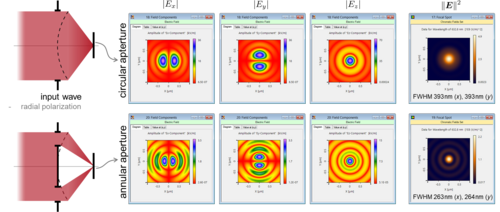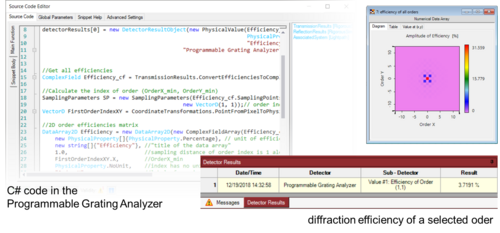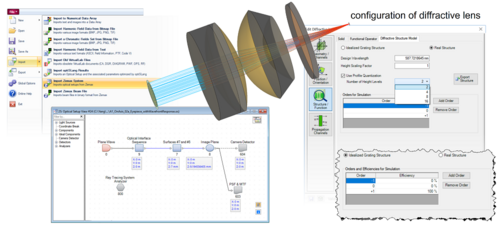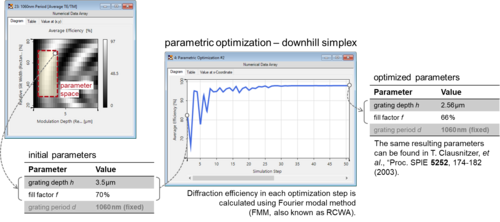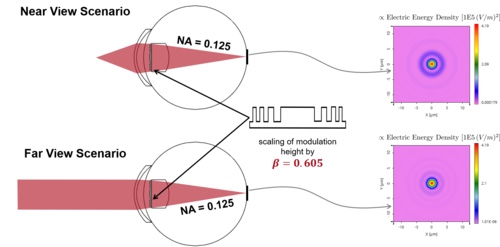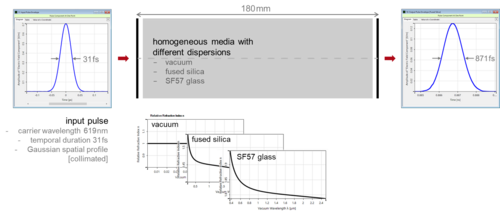What’s new in our Optical Modeling and Design Software?
Tightly Focused Light
How to focus light into an ever-smaller spot is an ever-present question in the optics community. Various approaches with the aim to focus light tightly have been developed, particularly of late. Investigation of light focusing under a high-NA configuration often requires fully vectorial electromagnetic simulation techniques. We demonstrate, using the software VirtualLab Fusion, how different polarization states (e.g. radial) and aperture shapes (e.g. annular) may influence the electromagnetic field in the focal region. Such analyzes can be done either with idealized lenses, or with real lenses with explicit structure and material information.
Read moreCustomize VirtualLab Fusion to Fit Your Needs!
We would like to provide full flexibility in VirtualLab Fusion so as to be able to meet the specific needs of the wide range of modeling or design tasks that can be tackled with the software. This versatility can be realized with various types of programmable elements in VirtualLab Fusion, from source to detectors, through components, and many more. Here we demonstrate two examples: a customized analyzer and a module. In the first example, a programmable grating analyzer is used to read and display specific grating diffraction properties for further analysis; the second example shows how to control an IFTA design via a customized module, avoiding the graphical user interface of the software.
Read moreHybrid Lens Simulation
Hybrid optical lenses with both refractive and diffractive surfaces have already proved useful in many applications. As an example, we showcase a hybrid eyepiece with just such a construction, i.e. it consists of both refractive and diffractive surfaces. We analyze in particular how to exploit the dispersion property of diffractive optics to correct chromatic aberration. Since the Summer Release 2019, VirtualLab Fusion supports the import of Binary 2 surfaces from Zemax OpticStudio®, a feature that facilitates a convenient workflow for the analysis of such hybrid lens systems.
Read moreEOS Diffractive Optics 2019 – Program Overview
We are happy to announce that EOS has published the program of the conference. Take the chance and meet experts to talk about their latest research results in the field of photonics.
Jena, Germany | 16 – 19 September
Read moreCross-platform Optical Modeling and Design
The physical optics software VirtualLab Fusion is constructed as a platform to combine different in-built and customized field solvers to enable fast physical-optics simulation and design with ray tracing naturally embedded. This multi-solver concept is complemented by the possibility to use a cross-platform approach, where VirtualLab Fusion is accessed externally. In two examples we demonstrate an interaction with Matlab and Python. In this way, tools and algorithms from other programs or programming languages can be used to extend the options for simulation, optimization, design and post-processing.
Read moreBinary Grating Design Workflow
Binary gratings, with either straight or slanted side walls, have turned out to be the key components in many optical applications. Thanks to the advances in e.g. nanoimprint technology, the fabrication of this type of gratings with small, critical dimensions has become feasible. VirtualLab Fusion, with its inbuilt Fourier modal method (FMM, also known as RCWA) and different optimization algorithms, provides a complete user-friendly design workflow for binary gratings that also includes the subsequent analysis of fabrication errors, like rounded-edge effects.
Read moreComplete Workflow for the Design and Analysis of Diffractive Lenses
Diffractive lenses show great potential in various modern optical applications. VirtualLab Fusion, with its Summer Release 2019, provides a complete workflow for the design and analysis of diffractive lenses. It starts with the functional design of the wavefront phase response, which can also, alternatively, be imported from e.g. Zemax OpticStudio®, then includes the actual microstructured lens surface into the modeling, and supports the export of the lens structure for fabrication. As an example, the design and analysis of an intraocular lens is shown.
Read moreUltrashort Pulses Modeling
Ultrashort laser pulses show a potential for high-precision material processing. However, such pulses may broaden due to the wide spectrum that corresponds to the ultrashort temporal duration. For ultrashort pulse applications it is important to understand the mechanism of pulse broadening, and even to control it. As examples, we demonstrate how material dispersion and diffraction gratings can affect the pulse behavior.
Read more



